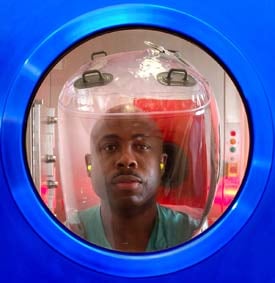 The news emerged in frightening fragments in the fall of 2001. Just a week after the horrors of 9/11, as the ruins of the World Trade Center still smoldered, the specter of bioterrorism appeared. A series of anonymous letters, each carrying a teaspoon of deadly anthrax spores, began delivering death and disease up and down the East Coast. Before it was over, this newâand anonymousâinvader had temporarily closed the halls of Congress and wreaked havoc with the U.S. mail. Five people were left dead, and 17 others were infected.
The news emerged in frightening fragments in the fall of 2001. Just a week after the horrors of 9/11, as the ruins of the World Trade Center still smoldered, the specter of bioterrorism appeared. A series of anonymous letters, each carrying a teaspoon of deadly anthrax spores, began delivering death and disease up and down the East Coast. Before it was over, this newâand anonymousâinvader had temporarily closed the halls of Congress and wreaked havoc with the U.S. mail. Five people were left dead, and 17 others were infected.
With the nationâs nerves on knife edge, Congress and the White House quickly launched an ambitious program to prepare for future biological attacks. Now, seven years later, $48 billion has been spent on biodefense, and President Bush has recommended spending another $9 billion next year.
A ProPublica review of the nationâs post-9/11 biodefense program, conducted in collaboration with Readerâs Digest and the national online biweekly multimedia news magazine, FLYPMEDIA, found a trail of wasteful spending and program failures laid out in the governmentâs own audits.
But those troubling findings seem like mere side notes when compared to the main concern of some scientists: that the $20 billion biodefense research program the government has undertaken in the past seven years has actually made us less safe than before by vastly increasing the number of researchers and labs authorized to handle deadly substances across America.
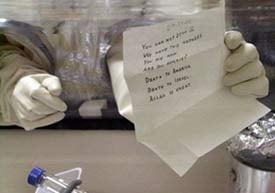 While the goal of the post-9/11 biodefense program was to protect the nation from a biological attack waged by a rogue nation or terrorist group, the more immediate threat now is a lack of security and safety controls at the proliferating number of biodefense labs.
While the goal of the post-9/11 biodefense program was to protect the nation from a biological attack waged by a rogue nation or terrorist group, the more immediate threat now is a lack of security and safety controls at the proliferating number of biodefense labs.
Today, some 1,370 public and private labs and 14,000 scientists are authorized to store and handle bacteria and viruses of bioterrorism concern, known as âselect agents.â Some of the most dangerous and incurable agents, such as Ebola virus, can be handled only in hermetically sealed Biosafety Level 4 (BSL-4) labs, where scientists wear âspace suitsâ with an air supply to protect them against infection. Other agents, such as those responsible for anthrax and plague, can be treated with antibiotics and are studied in Biosafety Level 3 (BSL-3) labs that have fewer safety precautions. Some of these labs are run by federal or state agencies, others by universities or private companies.
Because so many scientists have been authorized to work with select agents, the odds of one of them turning out to be a bad apple has increased.
âThe simplest, most likely path for an individual or group to acquire a bioweapons capability is to obtain bioweapons agents and training by penetration of a U.S. bioweapons-agents research project,â said Richard H. Ebright, a scientist at the Waksman Institute of Microbiology at Rutgers University in New Jersey. âOne well-placed graduate student, post-doctoral fellow or technician . . . . Itâs only a matter of time.â
Ebright estimates that the number of labs capable of handling the most dangerous pathogens has increased 20-fold since funding was increased in 2001.
 The prospect of a rogue scientist is already more than mere conjecture. When the government released its case against the man they believe engineered the 2001 anthrax attacks, it was a long-time research scientist named Bruce Ivins, who worked on anthrax vaccines at the Armyâs germ warfare lab in Fort Detrick in Maryland. Ivins, who had become emotionally troubled in recent years, committed suicide before the government could try to prove its case in court.
The prospect of a rogue scientist is already more than mere conjecture. When the government released its case against the man they believe engineered the 2001 anthrax attacks, it was a long-time research scientist named Bruce Ivins, who worked on anthrax vaccines at the Armyâs germ warfare lab in Fort Detrick in Maryland. Ivins, who had become emotionally troubled in recent years, committed suicide before the government could try to prove its case in court.
âThere is no question that the proliferation of research [on dangerous pathogens] is leaving us less secure by the dayâ said Brian Finlay, a senior associate at the Henry L. Stimson Center, a nonprofit think-tank focused on reducing the dangers of nuclear, chemical, and biological weapons.
The danger is heightened, the analysts said, because the federal government doesnât monitor the rapidly proliferating high-containment labs that work with dangerous pathogens such as SARS, which are not considered select agents.
According to a 2007 report by the U.S. Government Accountability Office (GAO), the watchdog arm of Congress, âThe limited federal oversight that does exist for high-containment labs is fragmented among different federal agencies, and for the most part relies on self-policing. . . . No agency is responsible for determining the aggregate risks associated with the expansion of these labs.â
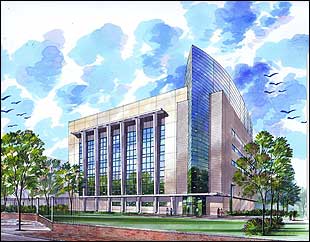 Communities where the labs are being built are registering their own concerns. The opening of a $128 million BSL-4 lab in metropolitan Boston has been delayed by legal action because it would put a facility containing some of the most deadly pathogens in the heart of a densely populated neighborhood. An expansion of the lab facilities at Fort Detrick has also raised concerns about evacuation plans and other contingencies in the event of an accident.
Communities where the labs are being built are registering their own concerns. The opening of a $128 million BSL-4 lab in metropolitan Boston has been delayed by legal action because it would put a facility containing some of the most deadly pathogens in the heart of a densely populated neighborhood. An expansion of the lab facilities at Fort Detrick has also raised concerns about evacuation plans and other contingencies in the event of an accident.
Since 2001, the number of BSL-4 labs has increased from five to 15, the GAO said. But no agency knows for sure how many BSL-3 labs exist, because the labs arenât required to register with the government unless they store or work with select agents. Last year, 1,356 BSL-3 labs that fall into this category were registered with either the Centers for Disease Control (CDC) or U.S. Department of Agriculture, according to the GAO. But the congressional oversight agency offered no estimate of how many unregistered BSL-3 labs might be operating.
Perimeter security at many BSL-4 labs remains inadequate, according to a September GAO report that looked at security at five of the nationâs 14 BSL-4 labs. A Georgia State University BSL-4 lab in downtown Atlanta lacked security barriers, cameras and guards, according to the GAO. âDuring our assessment, we saw a pedestrian access the building housing the lab through the unguarded loading dock entrance,â the report said.
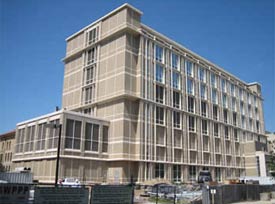 A new BSL-4 lab has been built at the University of Texas medical school in Galveston, on a barrier island that was hit recently by Hurricane Ike. Ike caused no damage more serious than a puddle in the buildingâs lobby, but it highlighted doubts about the prudence of putting a lab used to experiment with some of the worldâs deadliest pathogens on a barrier island in the middle of a hurricane path.
A new BSL-4 lab has been built at the University of Texas medical school in Galveston, on a barrier island that was hit recently by Hurricane Ike. Ike caused no damage more serious than a puddle in the buildingâs lobby, but it highlighted doubts about the prudence of putting a lab used to experiment with some of the worldâs deadliest pathogens on a barrier island in the middle of a hurricane path.
At some of the registered BSL-3 labs, researchers have been accidentally exposed to pathogens. According to the GAO, several incidents of accidental infections at Texas A&M University went unreported until a private watchdog organization called the Sunshine Project disclosed them. Last year, the CDC temporarily halted work at the Texas A&M facility. It said the school had allowed unauthorized access to select agents, misplaced vials of highly infectious bacteria and kept poor records on who entered the labs.
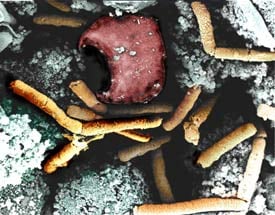 In Atlanta, a power outage occurred at a CDC lab while the backup generators were down, temporarily cutting off power to a critical safety device that was supposed to keep pathogens from escaping a containment area. Afterward, duct tape was used for more than a year to seal the door of the containment area in the $214 million facility.
In Atlanta, a power outage occurred at a CDC lab while the backup generators were down, temporarily cutting off power to a critical safety device that was supposed to keep pathogens from escaping a containment area. Afterward, duct tape was used for more than a year to seal the door of the containment area in the $214 million facility.
Even people who support increased biodefense research wonder why so many new labs are needed.
âItâs not clear to me what weâre going to do with all of them, frankly,â said Tara OâToole, director of the Center for Biosecurity at the University of Pittsburgh Medical Center.


